Why doesn’t this restaurant take reservations?
“It’s an age-old fight for the restaurateur,” says Jeff Black, who allows reservations at Black Market Bistro and BlackSalt but not at Pearl Dive Oyster Palace. “You get caught between trying to look out for the customer and trying to look out for the business.” Here’s the rationale: At places that take reservations, hardly anyone jockeys to snag a 5 p.m. slot via OpenTable. Stop taking reservations and you can end up creating demand for a crowd who’d rather come at 5 than wait for hours during prime time. Restaurateurs also claim that a walk-in-only policy eliminates the risk of no-shows, a constant burden on the bottom line.
Amazingly, some chefs are trying to argue that doing away with reservations actually enhances the experience when you finally score a seat. “We’re not forced to kick people out due to the ‘next reservation’ needing the table,” Rose’s Luxury chef/owner Aaron Silverman says. “Once you sit down, you get as much time as you want.”
That may be one way of looking at it, but we’d much rather save ourselves the three hours it takes to get one of his tables.
Why is my entrée so cheap?
Because your starter probably cost nearly as much. Entrée prices are the yardstick most people use to measure a place’s priciness before going. You might look at a menu and think, “Main courses for $20—not too bad.” As a result, some restaurateurs have ratcheted down prices on those dishes. What they don’t want you to notice is that they’re hiking up appetizer prices almost in direct pro-portion. So at a place like Birch & Barley, your $19 risotto might follow $18 sweetbreads. And that doesn’t even take into account the fact that some restaurants’ entrées don’t come with sides—another $10 each—or the pesky “snacks for the table” section so common on menus today. Our advice on entrées? See our 8 Hacks to Eating Out.
Why is my drink so sweet?
When you want to dispatch the disappointments of the day, you turn to a Manhattan, a Sazerac, a Negroni—a drink that has endured through the ages, a drink that stings. This isn’t the stuff of the craft-cocktail movement. Many bartenders say they aim for a light and agreeable libation: sweet, or sweet-and-smooth, drinks in which the hard uppercut of the bourbon, gin, and rye is leavened by syrups (house-made, of course), vermouths, bitters (which are actually not bitter but sweet), and, yes, even sugar itself. Not the first thing you’d reach for at home, but a smart move for restaurateurs. Sweet appeals to people just beginning to broaden their palates—namely, the young and restless who tank down cocktails with abandon—and a sweet, smooth drink goes down fast. So fast that before your meal has really gotten started, you’ve already dropped 30 bucks. Cha-ching!
Why are restaurants so loud these days?
You know it—the highly rated yet raucous joint where the arm of the dude depositing your delicate beet salad is as baroquely inked as a Victorian scroll, the pace of the meal is as frenetic as a jam session, and you have to become a screaming frontman to make yourself heard. What’s the deal? The rise of hyper-masculine bro culture, for one thing—perpetuated by expletive-spewing, Wu Tang-loving chefs like Toki Underground’s Erik Bruner-Yang and Seasonal Pantry’s Dan O’Brien. For another, the current taste for edgy, raw design. Numerous restaurateurs have ditched sound-absorbing carpeting and linens for exposed-brick walls and hanging pipes—basically, hard surfaces that amp up the noise. Roaring volume equals high energy equals big crowds, goes the thought process. “At Graffiato, that was the whole concept,” says owner Mike Isabella. “Super-loud, super-packed—it’s my style.”
This is an expensive meal. Why is my server wearing jeans?
Increasingly, the most exciting spots are slouchy propositions, where a T-shirt and flip-flops seem not merely acceptable but appropriate. (Great if you’re young and trendy, less so if you’re not.) This has coincided with what we like to think of as the invisible-white-tablecloth restaurant: a place that pretends to be casual, like a trust-funder who affects an air of slovenliness. The servers wear jeans and joke with you, but they still fold your napkin when you go to the bathroom. Boomers initiated the turn toward more casual dining, but it’s the influx of foodie-conscious millennials in the area over the past decade that has accelerated the transformation of our scene from buttoned up to buttoned down.
Why are my small plates appearing at random?
“The plates will come out when the kitchen sends them.” That line—heard at any tapas, mezze, or small-plates restaurant—sounded like fun during the early, heady days of the movement. But now it feels like a warning: Going out for small plates means submitting to a night of barely controlled chaos. You don’t get one or two plates at a time—you get several. And it only gets worse come round two, as everyone at the table is obliged to play server, moving stemware and cutlery and pawning off empty plates on the person who’s getting paid to do so. Chefs could pace these meals, but they choose not to—it’s easier for them not to have to keep track of so many dishes, they say. (We say: laziness.) Their other rationale: Because each dish is small and inexpensive, we can surely put up with a little inconvenience. This would make sense if we were eating only one or two dishes. But chances are we’re eating at least four or five—and paying about the same tab that we would at any pedigreed, non-small-plates restaurant.
Why can’t I Instagram my meal?
Your beloved iPhone cam is verboten at places like Komi—fine, we get that the chef wants customers paying $135 for a tasting menu to enjoy it without irritating distractions and nonstop selfies at the next table. But oddly, the no-photography rule is creeping into more laid-back and accessible restaurants like Cork on 14th Street. The main reason: Most quick-snap food pics are grainy, poorly lit, and downright unappetizing. (Even Martha Stewart famously sucked at Instagramming.) What chef would want his or her lovingly braised lamb shank memorialized as a sloppy brown mess? Still, when we’re unwinding at a neighborhood bistro, the last thing we want to worry about is following a rule.
This article appears in our November 2014 issue of Washingtonian.

















